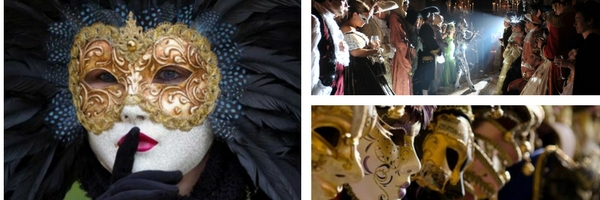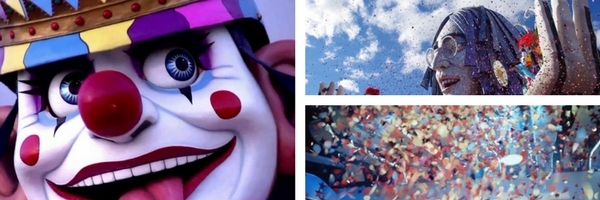Masks, confetti, streamers, lights and colors are just some of the key words of the craziest time of the year: Carnival is arriving. In few days every city city in Italy is going to celebrate Carnival with parades, masquerade balls, entertainment, music, and parties. Italy has many Carnevale celebrations, but Venice and its traditional masks, Viareggio with the parade of allegorical floats, and the battle of oranges in Ivrea hold the biggest and most elaborate festivals. Many other Italian towns hold carnival festivals, some with very unusual events. Children are going to throw confetti at each other. Everybody is going to put on a mask. But what is the ancient meaning of the Venetian Carnival Masks? And what is the history of Confetti?
VENICE, BEHIND A MASK…

The Carnival of Venice is the Carnival of all Italian Carnivals. Wearing a mask in Venice was a way to abandon the rational life and follow the primordial instincts. In the past, during the Carnival of Venice, everything was legitimate: the casinos were open 24 hours a day, the theatres hosted bawdy comedies every night and in every building noble families competed in organizing the most sumptuous parties. The Carnival lasted several months, from Christmas to Easter, and then there was the chance to vent the lowest instincts! The mask allowed anyone to be able to turn freely around the city without being recognized: privacy was assured! These serious excesses forced the Venetian Republic to issue a series of decrees to limit abuses and fraudulent use of masks and costumes in Venice, measures that gradually went to undermine the very essence of the Carnival in Venice and the origins of freedom and equality. With the fall of the Venetian Republic in 1797, a permanent ban of Venice Carnival costumes arrived, with the exception of private parties in Venetian palaces. The last Carnival in Venice is dated at 1797. Only from 1967 the first parties were reorganized with parades of masks and costumes, bringing back to life traditions and the Venice Carnival history. In 1979 a program to engage the inhabitants of Venice in the Venetian festivities was drafted for the first time to return the Carnival of Venice to its origins… The new formula has become a success story that has been going on for thirty years.
CONFETTI OF HAPPINESS

Confetti (called Coriandoli in Italian) have been a central element of Italian Carnevale for centuries and their story is actually quite remarkable. Back in the 14th century in Italy it was common to throw objects into the crowd at parades as part of an enduring tradition. While members of high society threw with coins or perfume-filled eggs the lower-class people began throwing back mudballs and rotten eggs to mock the wealthy people. When mud balls and eggs were finally banned, people were frantically searching for alternatives. After all, a carnival parade is not complete without throwing stuff at random people. Eventually, candy was allowed to be used as projectiles. As sugar-coated coriander was widely available, this became the go-to alternative, which is also the reason why the Italian word for confetti is ‘coriandoli’. In the end, even candy was deemed too dangerous for the massive and often violent foodfights that occured. In 1876 the fourteen year old Ettore Fenderl was watching a carnival parade passing beneath his house. Lacking expensive confetti or rose petals to throw on the parade, he cut coloured paper into very small pieces to throw on the masked figures passing below. People nearby quickly followed suit, and the practice rapidly spread to Vienna, Venice, and eventually all over the world. And that is how confetti was invented. Nowadays, a literally incalculable amount of confetti is used every year, not only at Carnival time, but also at weddings, parties, shows: during NYE on Times Square about 30,000,000 pieces of the colored paper is used in under a minute!!!
